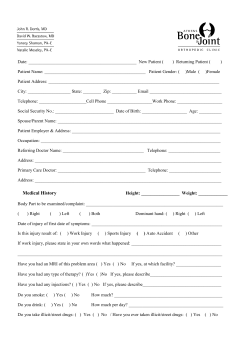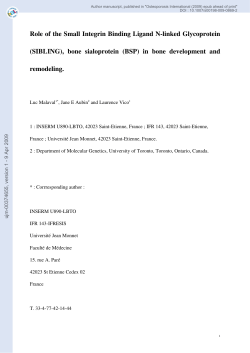
Notes for presentation:
Notes for presentation: Temporary Brittle Bone disease and Abusive Head Trauma: Lack of evidence for a fundamentally flawed belief system. Dr Jan Connors In 1990 Dr Colin Patterson published a paper (Paterson, 1990) suggesting that there was a condition where the bones of young children were found to be weak for a short period of time and he coined the term Temporary Brittle Bone Disease (TBBD). This was followed by his paper in 1993 (Paterson, 1993) in which he proposed that the condition of TBBD may be due to copper deficiency. Since that time there has been ongoing debate in the literature, as recent as 2013, as to whether such a condition does indeed exist, and if so, what the underlying cause is. On reviewing the evidence for and against the condition, it can be said that there is no evidence to support the existence of TBBD; that the rationale used by the proponents of this condition is fundamentally flawed. Over the years the proponents of TBBD have shown a lack of knowledge of the evidence base known to clinicians working in the area of forensic medical assessment of injury including mechanism of injury. Over 23 years, published articles have included significantly flawed methodology and make statements that are not backed by fact. In that 23 years the published literature has added little, reviewing the same or similar cohort and repeating already published findings and conclusions. The articles state beliefs rather than what is based in science. Journals continue to publish these articles without appropriate peer review, and continue to portray belief as fact. The presentation will outline how the debate has unfolded over the past 23 years, the various explanations that have been proposed for TBBD and review the validity of such proposals. References: • AYOUB, D., PLUNKETT, J., KELLER, K. A. & BARNES, P. D. 2010. Are Paterson's critics too biased to recognise rickets? Acta Paediatr, 99, 1282. • BAWLE, E. V. 1994. Osteogenesis Imperfector vs Child Abuse. American Journal of Medical Genetics, 49, 131. • BEIGHTON, P., SOLOMON, L. & SOSKOLNE, C. L. 1973. Articular mobility in an African population. Ann. Rheum Dis, 32. • CHAPMAN, S. & HALL, C. M. 1997. Non-accidental injury or brittle bones. Pediatr Radiol, 27, 106-110. • HICKS, R. 2001. Relating to methodological Shortcomings and the Concept of Temporary Brittle Bone Disease. Calcified Tissue International, 68, 316-319. • HYMAN, C. J. 2010. Response to Paterson. Acta Paediatr, 99, 1280-1284. • JENNY, C. & APA, C. O. C. A. A. N. 2006. Evaluating infants and young children with multiple fractures. Pediatrics, 118, 1299-303. • MENDELSON, K. L. 2005. Critical review of 'temporary brittle bone disease'. Pediatr Radiol, 35, 10361040. • MILLER, M. E. 1999. Temporary brittle Bone Disease: A True Entity? Seminars in Perinatology, 23, 174182. • MILLER, M. E. 2001. Reply to Hicks. Calcified Tissue International, 68, 317-319. • MILLER, M. E. 2003. The lesson of temporary brittle bone disease: all bones are not created equal. Bone, 33, 466-474. • MILLER, M. E. 2005. Hypothesis: foetal movement influences foetal and infant bone strength. Medical Hypotheses, 65, 880-886. • MILLER, M. E. 2009. The death of temporary brittle bone disease is premature. Acta Paediatr, 98, 1871-3. • MILLER, M. E. & HANGARTNER, T. N. 1999. Temporary Brittle Bone Disease: Association with Decreased Foetal Movement and Osteopenia. Calcif Tissue Int, 64, 137-143. • PATERSON, C. R. 1990. Osteogenesis imperfector and other bone disorders in the differential diagnosis of unexplained fractures. Journal of the Royal Society of Medicine., 83, 72-74. • PATERSON, C. R. 1993. Osteogenesis Imperfector: The Distinction from Child Abuse and the Recognition of a Variant Form. American Journal of Medical Genetics, 45, 187-192. • PATERSON, C. R. 1995. Osteogenesis Imperfector Variant Vs Child Abuse. American Journal of Medical Genetics, 56, 117-118. • PATERSON, C. R. 2009. Temporary brittle bone disease: fractures in Medical care. Acta Paediatr, 98, 1935-8. • PATERSON, C. R. 2010. Bone disorders that cause fractures and mimic non-accidental injury. Acta Paediatr, 99, 1281-2. • PATERSON, C. R. 2011. Temporary brittle bone disease: the current position. Arch Dis Child, 96, 901902. • PATERSON, C. R., BURNS, J. & MCALLION, S. J. 1994. Reply to Bawle: Temporary Brittle Bone Disease. American Journal of Medical Genetics, 49. • PATERSON, C. R. & MOLE, P. A. 2012. Joint laxity in the parents of children with temporary brittle bone disease. Rheumatol Int, 32, 2843-2846. • PATERSON, C. R. & MONK, E. A. 2011. Temporary brittle bone disease: relationship between clinical findings and judicial outcome. Pediatric Reports, 3, 97-99. • PATERSON, C. R. & MONK, E. A. 2013. Temporary brittle bone disease: association with intracranial bleeding. J Pediatr Endocrinol Metab, 26, 417-426. • RODRIGUEZ, J. I., GARCIA-ALIX, A., PALACIOS, J. & PANIAGUA, R. 1988. Changes in the long Bones Due to Foetal Immobility caused by Neuromuscular Disease. The Journal of Bone and Joint Surgery, 70-A, 1052-1060. • SHAW, D. G., HALL, C. M. & CARTY, H. 1995. Osteogenesis Imperfector: The Distinction from Child Abuse and the recognition of a variant Form. American Journal of Medical Genetics, 56, 116. • SMITH, R. 1995. Oseogenesis imperfector, non-accidental injury, and temporary brittle bone disease. Arch Dis Child, 72, 169-176. • SPRIGG, A. 2011. Temporary brittle bone disease versus suspected non-accidental skeletal injury. Arch Dis Child, 96, 411-413. • SUTTON, A. M., HARVIE, A., COCKBURN, F., FARQUHARSON, J. & LOGAN, R. W. 1985. Copper deficiency in the preterm infant of very low birth weight. Archives of Disease in Childhood, 60, 644651
© Copyright 2025





















